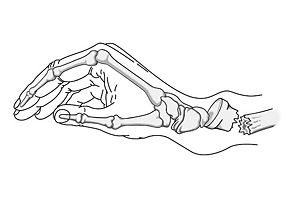Types of fracture: Difference between revisions
No edit summary |
|||
| Line 14: | Line 14: | ||
===Leg and Ankle=== | ===Leg and Ankle=== | ||
====Neck of femur==== | ====Neck of femur==== | ||
====Tibial==== | |||
===Tibial=== | ====Ankle==== | ||
===Ankle=== | |||
Revision as of 16:24, 1 December 2009
There are lots of fractures. We have tried to narrow it down a wee bit.

Arm and wrist
Top of humerus
Often breaks in the elderly after a fall. Also seen in RTAs. Can be treated conservatively with a collar-and-cuff. If it is comminuted (multiple pieces), may need open reduction and internal fixation.
Colles' fracture
Very common, especially in old osteoporotic ladies who fall forwards on an outstretched hand. You get a dorsal displacement. This means that the back of the hand (the bit with the nails on) goes a bit more backwards. Use some anaesthesia, then reduce it and put it in a backslab.
Smiths' fracture
This is known as a reverse Colles, as its exactly the same, except there is ventral displacement (the hand displaces forwards). It happens when you fall forwards on a flexed hand, or backwards on an outstretched one. Managed the same way.
Scaphoid fracture
Happens from falling on the hand. Get a pain in the anatomical snuff box. Important because there is only a distal blood supply, and a fracture down the middle can mean the proximal end doesn't get blood. Then is dies. That's bad. If it's broken, can usually be supported with a thumb and wrist cast, otherwise, might need surgery.